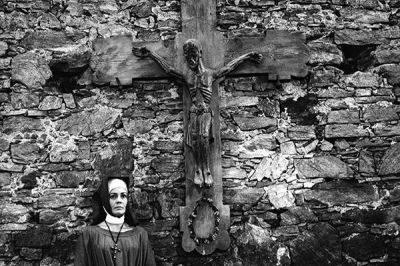
ÚDOLÍ VČEL
(Valley of the Bees / La valle delle api, Cecoslovacchia/1967) R.: Frantisek Vlácil. D.: 97'
Sog.: Vladimír Körner. Scen.: Vladimír Körner, František Vláčil. F.: František Uldrich. M.: Miroslav Hájek. Scgf.: Jindřich Goetz. Mus.: Zdeněk Liška. Su.: František Fabián. Int.: Petr Čepek (Ondřej di Vlkov), Jan Kačer (Armin von Heide), Věra Galatíková (Lenora), Michal Kožuch (Padre Blasius), Zdeněk Kryzánek (il padre di Ondřej), Josef Somr (Rotgier), Jana Hlaváčková (la ragazza cieca), Jana Hájková (Lenora ragazza), Zdeněk Sedláček (Ondřej ragazzo). Prod.: Filmové studio Barrandov. Pri. pro.: 17 maggio 1968. 35mm. D.: 97'. Col. Versione ceca con sottotitoli inglesi / Czech version with English subtitles
Da: Národní filmový archiv
František Vláčil potrebbe essere considerato un fenomeno del cinema cecoslovacco degli anni Sessanta, e solitamente è così che viene inquadrato. Essendo più anziano della terza generazione della FAMU (la Scuola di cinema e televisione della Accademia di arti dello spettacolo di Praga) e girando film del tutto originali rispetto al resto della produzione, non apparteneva realmente alla cosiddetta nouvelle vague cecoslovacca. Il suo linguaggio cinematografico si avvicina maggiormente a quello dell'immagine statica e del suono non realistico, più che alla testimonianza diretta del quotidiano e alla poesia della luce e del movimento. Il suo capolavoro Marketa Lazarová è lungo senza essere epico, crudo senza essere realistico, e impiega il simbolismo cristiano e pagano pur restando fondamentalmente laico. La valle delle api è per molti versi simile al film precedente, probabilmente (ma non solo) perché è stato concepito nello stesso periodo e deriva in parte dal suo più spettacolare predecessore.
Il film è un esempio della migliore fotografia in bianco e nero degli anni Sessanta. Anche se girato in widescreen anamorfico, non rinuncia a composizioni centrali o estreme. Non sono rare le inquadrature in cui i personaggi guardano direttamente in macchina. Si alternano interni bui ed esterni inondati di luce, campi lunghi e dettagli ravvicinati. A volte le immagini si fanno quasi astratte nel tracciare le forme e le superfici degli oggetti e del corpo umano. Tutto questo, insieme a un impianto sonoro non naturalistico, accentua in modo sorprendente il realismo complessivo del film, che ancora oggi stupisce per la sua interpretazione insolitamente moderna del genere storico.
Come Marketa Lazarová, il film è tratto da un romanzo. La valle delle api fu scritto da Vladimír Körner e adattato per lo schermo dallo stesso autore in collaborazione con Vlácil. Mentre lo sviluppo e la lavorazione di Marketa Lazarová durarono svariati anni, a detta del regista La valle delle api fu molto semplice da realizzare. Anche se il film verrà sempre messo in ombra dal suo più lungo e monumentale predecessore, può certamente essere considerato uno dei migliori titoli cecoslovacchi degli anni Sessanta, se non del cinema ceco in assoluto.
Anna Batistová
František Vláčil, director of Valley of the Bees, might be considered (and usually is) a phenomenon in the context of Czechoslovak cinema of the 1960s. Being older that the third generation of FAMU (the Film and TV School of the Academy of Performing Arts in Prague) and making films that were distinctly different from anything else, he did not really belong to the so-called Czechoslovak New Wave. His cinematic language is more closely aligned with that of static image and non- realistic sound, rather than direct testimony on everyday and the poetry of light and movement. His chef-d'oeuvre Marketa Lazarová is long but not epic, crude but not realistic, employing both Christian and pagan symbolism while still remaining rather worldly. Valley of the Bees bears many similarities, probably but not exclusively because it was developed in the same period, as an offset of its more spectacular predecessor.
The film presents 1960s black and white photography at its best. Though shot in anamorphic widescreen, the film does not avoid central or otherwise extreme compositions. Shots where characters stare directly into camera are not rare. Dim interior shots alternate with overlit exteriors. Long shots are followed by extreme details. And sometimes the images become almost abstract, as they trace the structures and surfaces of objects and human body. All of these, as well as rather non-naturalistic sound design, quite surprisingly add to the perceived realism of the film as a whole. Even today it surprises with its unusually modern concept of historical genre.
Just like Vlácil's Marketa Lazarová, the film is an adaptation of a novel. Valley of the Bees was written by Vladimír Körner and adapted for the screen by the author himself, in cooperation with Vlácil. While Marketa Lazarová took Vlacil years to develop and finish, Valley of the Bees was, according to the director himself, quite easy to put together. And although the film will probably always stay in the shadow of its longer and more monumental predecessor, it certainly can be considered one of the best films of the Czechoslovak 1960s, if not Czech cinema in general.
Anna Batistová

Tariffe:

Numero posti: 174
Aria Condizionata
Accesso e servizi per disabili
Il nostro cinema aderisce al circuito CinemAmico: è possibile utilizzare l’applicazione MovieReading® per i film di cui è prevista audiodescrizione e/o sottotitolazione sull'applicazione.
Tel. 051 2195311











